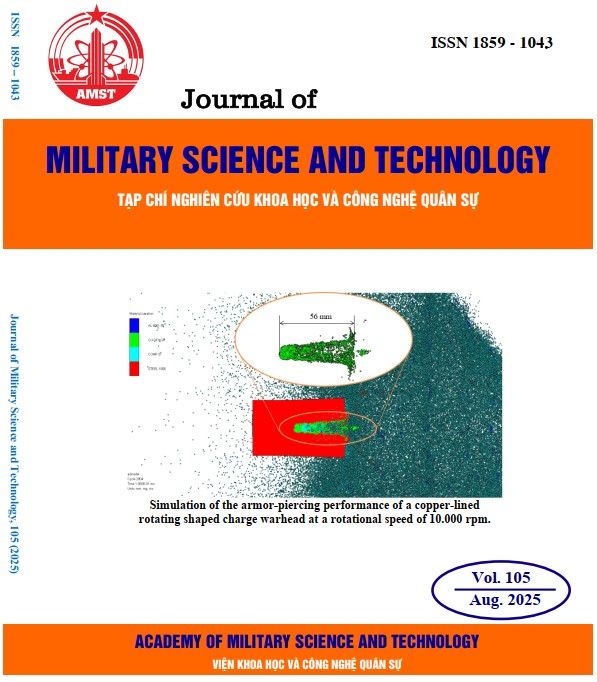Research on optimization of surface roughness of aspherical aluminum during Single-Point Diamond Turning using BBK model and PSO algorithm
223 viewsDOI:
https://doi.org/10.54939/1859-1043.j.mst.105.2025.147-154Keywords:
SPDT; Aspheric surface; Surface roughness; Box-Behnken; PSO.Abstract
The paper presents the results of optimizing the surface quality of aspheric aluminum during Single Point Diamond Turning (SPDT) based on the Box-Behnken Design (BBD) experimental method. The experimental dataset consists of 15 experiments established from the BBK model, supported by the ANOVA module in the specialized software DESIGN EXPERT. The objective function for roughness was established, resulting in a second-order multivariable regression equation that defines the roughness of the aspheric surface based on the data obtained after conducting all experiments. The objective function is formed based on the relationship between the roughness of the aspheric surface and the cutting parameters: spindle speed (n - RPM); feed rate (F - mm/min); and depth of cut (ap - mm). The modeling results, with a reliability of R2 =0.9536, show a high correlation between the model data and the experimental values. By using the Particle Swarm Optimization (PSO) algorithm, the optimal surface roughness value achieved is 0.8 nm, obtained under the machining conditions of n = 2000 RPM, F = 8 mm/min, and ap = 4.2 µm. This study is significant for enhancing the optical surface quality in ultra-precision machining and provides a reliable foundation for building experimental models to optimize and accurately assess the machining process.
References
[1]. S. Zhang et al., “Single-element laser beam shaper for uniform flat-top profiles,” Opt. Express, Vol. 11, No. 16, pp. 1942-1948, (2003). DOI: https://doi.org/10.1364/OE.11.001942
[2]. Y. Kawamura et al., “A simple optical device for generating square flat-top intensity irradiation from a Gaussian laser beam,” Precision Engineering, Vol. 48, No. 1, pp. 44-46, (1983). DOI: https://doi.org/10.1016/0030-4018(83)90246-8
[3]. Y. Dai et al., “Forced-based deviation tool induced form error identification in single-point diamond turning of optical spherical surfaces,” Precision Engineering, Vol. 72, pp. 83-94, (2021). DOI: https://doi.org/10.1016/j.precisioneng.2021.04.001
[4]. C.L. He et al., “Origins for the size effect of surface roughness in diamond turning,” Machine Tools & Manufacture, Vol. 106, pp. 22-42, (2016). DOI: https://doi.org/10.1016/j.ijmachtools.2016.04.004
[5]. G. M. Tambwe et al., “Optimization of Surface Roughness of Aluminium RSA 443 in Diamond Tool Turning,” Manufacturing and Materials Processing, Vol. 8, No. 2, pp. 61-83, (2024). DOI: https://doi.org/10.3390/jmmp8020061
[6]. F. Yaping et al., “Research of ultra precision machining technology,” Mechanics and Material, Vol. 687-691, pp. 476-479, (2014). DOI: https://doi.org/10.4028/www.scientific.net/AMM.687-691.476
[7]. M. Tauhiduzzaman et al., “Form error in diamond turning,” Precision Engineering, Vol. 42, pp. 22-36, (2015). DOI: https://doi.org/10.1016/j.precisioneng.2015.03.006
[8]. H. Gong et al., “Tool path generation of ultra-precision diamond turning: A state-of-the-art review,” Nanotechnology and Precision Engineering, Vol. 2, pp. 118-24, (2019). DOI: https://doi.org/10.1016/j.npe.2019.10.003
[9]. M. Tunesi et al., “Effect of resultant force direction in single point diamond turning of (111) CaF2,” Manufacturing Science and Technology, Vol. 55, pp. 411-419, (2024). DOI: https://doi.org/10.1016/j.cirpj.2024.11.001
[10]. M. N. A. Wahabi et al., “A Comprehensive Review of Swarm Optimization Algorithms,” PLOS ONE, Vol. 10, No. 5, (2015), DOI: 10.1371/journal.pone.0122827. DOI: https://doi.org/10.1371/journal.pone.0122827
[11]. A. Tharwat et al., “A conceptual and practical comparison of PSO-style optimization algorithms,” Expert Systems with Applications, Vol. 167, (2021), https://doi.org/10.1016/j.eswa.2020.114430. DOI: https://doi.org/10.1016/j.eswa.2020.114430
[12]. Montgomery DC “Design and Analysis of Experiments Eighth Edition,” Technometrics, Vol. 48, No.1, (2006), doi: 10.1198/tech.2006.s372. DOI: https://doi.org/10.1198/tech.2006.s372







